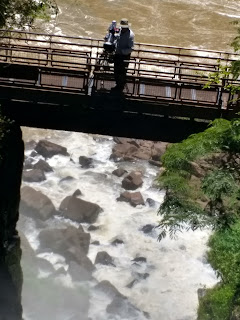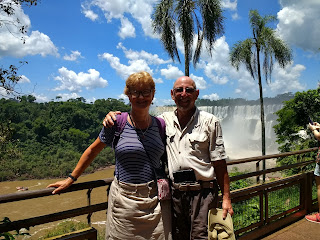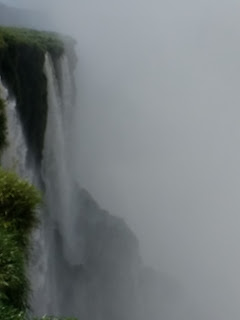Until we researched our trip to South America, we hadn't known that Iguazu Falls were easily reached from either side of the Argentine-Brazilian border as well as from nearby Paraguay. Flying from Buenos Aires yesterday to Puerto Iguazu, the town nearest the Argentine side of the falls brought us within spitting distance as my English mum would have said to Parque Nacional Iguazu. We had hoped to spend several hours at of one of the planet's most awe-inspiring sights the previous afternoon but our stupidity made that impossible when we first went to the wrong airport in Buenos Aires.
After entering the national park, it was tempting to head straight for the falls but we decided to go to the park's interpretive center first to get an appreciation of the park and its history. Ten thousand years ago, groups of hunter-gatherers occupied the forests of the Upper Parana and Iguazu rivers. The Guarani people entered the region 700 years ago in search of 'The Land Without Evil.' Coming from the Amazon region, the Guarani traveled along rivers in search of the paradise promised to them by their gods in dreams. The Guarani were known as the 'Lords of the Forest and its Rivers.'
According to Guarani tradition, the falls originated when a warrior named Caroba incurred the wrath of a forest god by escaping downriver in a canoe with a young girl, Naipur, with whom the god was infatuated. Enraged, the god caused the riverbed to collapse in front of the lovers, producing a line of precipitous falls over which Naipur fell and, at the base, turned into a rock. Caroba survived as a tree overlooking it.
To the Guarani, plants and animals were objects of respect and devotion. Nobody was idle in Guarani way of life. Men and women shared the community's daily responsibilities.
The forests were critical to the Guarani people as it was where they lived, their hunting ground, their pharmacy and their pantry. From the forests, they also got raw materials for making tools and utensils. They settled near rivers and moved every three years or so when the soil became exhausted and to allow the forests to grow back. They cultivated plants such as tobacco, manioc and maize they had brought with them on their migration from distant lands.
The Jesuits arrived in 1608 to evangelize the Guarani. Between the 17th and 18th centuries, the Society of Jesus or Jesuits founded 30 settlements which became home to over 100,000 Guarani inhabitants. The Jesuits observed and described the nature of the region and the customs of the indigenous people. The missionaries learned the Guarani language. Rather than teaching them Latin, they printed religious texts in Spanish and Guarani in the missions.
Coming from the airport yesterday, we had seen numerous signs cautioning people to be wary of coatis - animals that, though used to people, may attack and also transmit rabies to humans through bites, a scratch or a lick. As a result, we gave this one a wide berth!
There were few other people on the path which vastly increased our enjoyment of the morning's hike.
The first trail ended at the jungle train station where we heard the roar of the falls for the first time but we again chose to hike the Paseo Superior or Higher Circuit to catch our first glimpse of the falls.
We were so excited when we caught sight of our first set of falls called Salto Bosetti as Iguazu Falls was comprised of more than 270 cascades! When we started out that morning, it had been totally hazy, so we were relieved that it was beginning to clear up and the sun shone.
What a shame that some park guests had left out trash which attracted more coatis.
Our first view of the panorama was 1,000 times more impressive than our recollection of being at Victoria Falls in Zimbabwe for Thanksgiving in 2016.
It was hard to imagine a more astounding sight than this as the falls kept going on and on!
At almost every turn on the trail, we were treated to another fabulous cascade.
We had hoped to take a free launch at the end of the trail we were on to Isla San Martin, an island with a trail of its own that gave the closest look at several falls but unfortunately there had been too much rain recently to make it safe for the boats to cross.
Can you almost feel the mist as we did?!
We read a sign that said at the foot of the falls, the water produces a cauldron which undercuts the face. Over time, the unsupported rocks drop away. The basalt rocks we saw below were the results of this slow but continuous process.
The trail was absolutely phenomenal as we got so close to so many of the falls or cascades. Everywhere we looked there were more of them.
We relished the good soaking we got as it was hot and sticky! Quite a few people only wore swimsuits but that seemed a little overboard to us.
Another informational sign indicated the forests were like big green sponges as they absorbed and retained water before releasing it slowly to the rivers.
In 1982-3 and again in 1992, the normal volume of 1,750 cubic meters per second more than doubled and washed away whole islands and walkways. Conversely, the drought of 1978 almost dried up the falls.
Adan Waterfall:
More coati sightings!
An example of where rocks had fallen away from the cliffs and then created mini-islands.
Barely 40 years ago, the waters of the Iguazu River ran clear. Since then, with more and more forests being cleared in most of the watershed, each time it rains, water washes away the unprotected soil which turns the river red.
Another warning about the damage coatis could inflict!
After finishing the 1,750 meter long Upper Circuit trail, we continued on the slightly shorter Lower Circuit to see what incredible views it would show us.
Oops - we had to cautious of the jungle train crossing!
For years Guilermo Larrequi, a determined Basque, pushed his wheelbarrow containing all his possessions around the country. In 1948, he reached Iguazu where he stopped his wanderings. He built a small house and planted a garden with ornamental flowers from other parts of the country. Some of the plants, however, became problem species when they invaded the forest and competed with native flora.
Our views along the Lower Trail turned out to be as spectacular as they had been on the Upper one.
The trail descended to the river, passing delightfully close to falls on the way!
In this spot, we could just detect a musty smell which came from a crack in the rock face where there was a roost of Guano Bats.
We watched as a fellow tourist purposely put his backpack down to see what the coati would do. Seemingly, he had forgotten all the signs to be careful of them!
Finally, in the late afternoon we took the park's jungle train to the end of the line to the Garganta del Diablo or the Devil's Throat, which was reputed to be one of the planet's most spectacular sights.
From the train stop there was still a 1,100 meter long trail to the viewing platform.
The lookout platform was perched right over an amazingly powerful torrent of water where 14 separate waterfalls joined forces pounding down the 295-foot cliffs in a deafening crescendo of sound and spray!
The stupefying sight was made even more incredible by a perpetual rainbow in the late afternoon, reputedly the best time to visit Devil's Throat.
We remarked to each other that we couldn't possibly imagine a more stupendous natural sight in the world than coming upon Devil's Throat in the late afternoon and seeing the rainbow.
Behind Steven was the Brazil side of the falls which we would be seeing the following morning!
After entering the national park, it was tempting to head straight for the falls but we decided to go to the park's interpretive center first to get an appreciation of the park and its history. Ten thousand years ago, groups of hunter-gatherers occupied the forests of the Upper Parana and Iguazu rivers. The Guarani people entered the region 700 years ago in search of 'The Land Without Evil.' Coming from the Amazon region, the Guarani traveled along rivers in search of the paradise promised to them by their gods in dreams. The Guarani were known as the 'Lords of the Forest and its Rivers.'
According to Guarani tradition, the falls originated when a warrior named Caroba incurred the wrath of a forest god by escaping downriver in a canoe with a young girl, Naipur, with whom the god was infatuated. Enraged, the god caused the riverbed to collapse in front of the lovers, producing a line of precipitous falls over which Naipur fell and, at the base, turned into a rock. Caroba survived as a tree overlooking it.
To the Guarani, plants and animals were objects of respect and devotion. Nobody was idle in Guarani way of life. Men and women shared the community's daily responsibilities.
The forests were critical to the Guarani people as it was where they lived, their hunting ground, their pharmacy and their pantry. From the forests, they also got raw materials for making tools and utensils. They settled near rivers and moved every three years or so when the soil became exhausted and to allow the forests to grow back. They cultivated plants such as tobacco, manioc and maize they had brought with them on their migration from distant lands.
The Jesuits arrived in 1608 to evangelize the Guarani. Between the 17th and 18th centuries, the Society of Jesus or Jesuits founded 30 settlements which became home to over 100,000 Guarani inhabitants. The Jesuits observed and described the nature of the region and the customs of the indigenous people. The missionaries learned the Guarani language. Rather than teaching them Latin, they printed religious texts in Spanish and Guarani in the missions.
Following the Spanish Crown's decision to expel the Jesuits from South America in 1767, the settlements were abandoned and covered little by little by the returning forest.
According to the information we leaned from the visitors' center, the Guarani today are a living people and language. Their traditional way of living is thriving. Their music is played on native instruments and on others often inherited from the Jesuits or others from Spanish descent. They keep up their handicrafts and their dance rituals continue.
As we entered the park, a warning sign advised us we were entering 'a wild, natural area that involved risks to our safety and health caused by the force of nature!' We could have taken a brief train ride to where the waterfalls walks began, but we preferred to take the Sendero Verde or Green Trail to get a sense of the park's incredible rainforest.
We read that high temperatures, humidity and rainfall contributed to the diverse habitat. The park's rainforest contained more than 2,000 plant species, countless insects, 400 species of birds, and many mammals and reptiles.Coming from the airport yesterday, we had seen numerous signs cautioning people to be wary of coatis - animals that, though used to people, may attack and also transmit rabies to humans through bites, a scratch or a lick. As a result, we gave this one a wide berth!
There were few other people on the path which vastly increased our enjoyment of the morning's hike.
The first trail ended at the jungle train station where we heard the roar of the falls for the first time but we again chose to hike the Paseo Superior or Higher Circuit to catch our first glimpse of the falls.
We were so excited when we caught sight of our first set of falls called Salto Bosetti as Iguazu Falls was comprised of more than 270 cascades! When we started out that morning, it had been totally hazy, so we were relieved that it was beginning to clear up and the sun shone.
What a shame that some park guests had left out trash which attracted more coatis.
Our first view of the panorama was 1,000 times more impressive than our recollection of being at Victoria Falls in Zimbabwe for Thanksgiving in 2016.
It was hard to imagine a more astounding sight than this as the falls kept going on and on!
We were close enough to feel the power of the falls' spray on the trail.
At almost every turn on the trail, we were treated to another fabulous cascade.
We had hoped to take a free launch at the end of the trail we were on to Isla San Martin, an island with a trail of its own that gave the closest look at several falls but unfortunately there had been too much rain recently to make it safe for the boats to cross.
Can you almost feel the mist as we did?!
We read a sign that said at the foot of the falls, the water produces a cauldron which undercuts the face. Over time, the unsupported rocks drop away. The basalt rocks we saw below were the results of this slow but continuous process.
The trail was absolutely phenomenal as we got so close to so many of the falls or cascades. Everywhere we looked there were more of them.
We relished the good soaking we got as it was hot and sticky! Quite a few people only wore swimsuits but that seemed a little overboard to us.
Another informational sign indicated the forests were like big green sponges as they absorbed and retained water before releasing it slowly to the rivers.
In 1982-3 and again in 1992, the normal volume of 1,750 cubic meters per second more than doubled and washed away whole islands and walkways. Conversely, the drought of 1978 almost dried up the falls.
Adan Waterfall:
More coati sightings!
An example of where rocks had fallen away from the cliffs and then created mini-islands.
The river's cloudiness meant fish cannot find each other to court and spawn and birds and mammals which feed on fish cannot see their prey. Luckily, dams upriver act as sedimentation tanks which lessen the problem.
A recently constructed final section of the Paseo Superior crossed a large swath of the Iguazu River ending above the powerful San Martin Waterfall before wending its way back across some river islands.
Another warning about the damage coatis could inflict!
After finishing the 1,750 meter long Upper Circuit trail, we continued on the slightly shorter Lower Circuit to see what incredible views it would show us.
Oops - we had to cautious of the jungle train crossing!
For years Guilermo Larrequi, a determined Basque, pushed his wheelbarrow containing all his possessions around the country. In 1948, he reached Iguazu where he stopped his wanderings. He built a small house and planted a garden with ornamental flowers from other parts of the country. Some of the plants, however, became problem species when they invaded the forest and competed with native flora.
Our views along the Lower Trail turned out to be as spectacular as they had been on the Upper one.
The trail descended to the river, passing delightfully close to falls on the way!
In this spot, we could just detect a musty smell which came from a crack in the rock face where there was a roost of Guano Bats.
We watched as a fellow tourist purposely put his backpack down to see what the coati would do. Seemingly, he had forgotten all the signs to be careful of them!
Yeah - another free drenching at the end of the trail. I loved it as you can perhaps tell from my grin!
On the way back, we were treated to birds cavorting in the limbs above us.
As again we were overwhelmed with one more jaw-dropping view after another, we wondered which falls in the world were considered the 'best.' We were reminded of Eleanor Roosevelt's comment on first seeing the falls, "Poor Niagara!" Some of the park's 275 individual falls were more than 260 feet high and plunged over a 2-mile precipice!
Finally, in the late afternoon we took the park's jungle train to the end of the line to the Garganta del Diablo or the Devil's Throat, which was reputed to be one of the planet's most spectacular sights.
From the train stop there was still a 1,100 meter long trail to the viewing platform.
What contributed to making our visit to the Argentine side of Iguazu Falls so fantastic were the incredible pathways to each of the park's individual sites which made the falls so accessible.
The lookout platform was perched right over an amazingly powerful torrent of water where 14 separate waterfalls joined forces pounding down the 295-foot cliffs in a deafening crescendo of sound and spray!
The stupefying sight was made even more incredible by a perpetual rainbow in the late afternoon, reputedly the best time to visit Devil's Throat.
We remarked to each other that we couldn't possibly imagine a more stupendous natural sight in the world than coming upon Devil's Throat in the late afternoon and seeing the rainbow.
Behind Steven was the Brazil side of the falls which we would be seeing the following morning!
Next post: A very different perspective of Iguazu Falls from the Brazilian side.
Posted on May 25th, 2018, from Grayton Beach State Park in Florida where a tropical storm is threatening our beach vacation!













































































































No comments:
Post a Comment